Abstract
Metal-organic frameworks are a class of attractive materials for fluorescent sensing. Here, we report the exploration of fluorescent Zn-based amine/azine-functionalized MOF, TMU-17-NH2, ([Zn(NH2-BDC)(4-bpdb)].2DMF; NH2-BDC = amino-1,4-benzenedicarboxylic acid, 4-bpdb = 1,4-bis(4-pyridyl)-2,3-diaza-2,3-butadiene) for highly selective and sensitive detection of Fe3+ in DMF (N,N-dimethylformamide) solution. TMU-17-NH2 shows fast recognition of Fe3+ ions with a response time of <1 min and detection limit of 0.7 µM (40 ppb), and the luminescence is completely quenched in 10−3 M DMF solution of Fe3+. Furthermore, no interferences from 250 μM As3+, Cd2+, Zn2+, Co3+, Ni2+, Cu2+, Pb2+, Mn2+ and Al3+ were found for the detection of Fe3+, which suggests that functionalized TMU-17-NH2 is a promising luminescent probe for selectively sensing iron ions.
1. Introduction
Metal ions play key roles in life and the environment, and the detection of these metal ions is quite important. Iron is an important metal in industry [1]. Fe3+ ion is one of the most essential elements for either humans or other living organisms on account of their significance in many biochemical processes and biological systems. Iron deficiency or excess will both lead to various severe function condition disorders, such as sleep loss, skin diseases, iron deficiency anemia and decreased immunity [2]. Therefore, the selective detection of Fe3+ is a very important subject in biological research as well as in the water treatment industry.
Metal-organic frameworks (MOFs), formed by the connection of metal centers or clusters and organic linkers through coordination bonding, have gathered immense attention due to not only their intriguing structures of diverse pore topologies and accessible cages and tunnels, unusual properties of permanent nanoscale porosity, high surface area, and the availability of in-pore functionality and outer-surface modification, but also their application potential in gas storage, separation, catalysis, proton conduction, sensing and so on [3].
Until now, several MOFs have shown good performance for the detection of Fe3+ ions [4,5,6]. However, the detection processes of these MOFs towards Fe3+ ions take a relatively long time because their detection mechanisms are based on the ion exchange between the framework metal ions and Fe3+ ions. Thus, there is an urgent need to develop new fluorescent MOF sensors for the selective and fast detection of Fe3+ ion. Although excellent studies on a highly selective fluorescent probe for the detection of Fe3+ were reported by Zhou et al. [7], Sun et al. [6], and Wang et al. [8], the advantage of TMU-17-NH2 is that the overall quenching constant for Fe3+ in the concentration range of 50–250 μM is quantified to be ~41,000 M−1 and with a detection limit of 0.7 µM, which is comparable to that of other reports. It is very exciting that TMU-17-NH2, as an Fe3+-probe, was not influenced by the presence of other metal ions such as As3+, Cd2+, Zn2+, Co3+, Ni2+, Cu2+, Pb2+, Mn2+ and Al3+.
2. Experimental Section
Chemicals, Reagents and Apparatus
Starting reagents for the synthesis were purchased and used without further purification from commercial suppliers (Sigma-Aldrich, Merck and others). Zn(NO3)3·6H2O and amino-1,4-benzenedicarboxylic acid (NH2-BDC) were used to synthesize TMU-17-NH2. N, and N-Dimethylformamide (DMF) was used as the solvent to purify TMU-17-NH2. Aqueous solutions of Cd2+, Zn2+, Pb2+, Co2+, As3+, Mn2+, Al3+, Cu2+, Ni2+ and Fe3+ were prepared from CdCl2·2.5H2O, Zn(NO3)3·6H2O, Pb(NO3)2, Co(NO3)2·6H2O, NaAsO2, Ni(OAc)2·4H2O, Al(NO3)3·9H2O, Cu(NO3)2·3H2O, MnCl2·6H2O, and Fe(NO3)3·9H2O, respectively. X-ray powder diffraction (XRD) measurements were performed using a Philips X′pert diffractometer with monochromated Cu-kα radiation (λ = 1.54056 Å). The simulated XRD powder pattern based on single crystal data was prepared using Mercury software. The fluorescence experiments were performed at room temperature on a Shimadzu RF-6000 fluorescence spectrometer (kyoto, Japan) with a photomultiplier voltage of 700 V, scan speed of 60,000 nm min−1, excitation slit width of 900 nm, emission slit width of 200–800 nm, and a 380 nm optical filter. The fluorescent emission spectra were recorded in the wavelength range of 300-800 nm upon excitation at 270 nm.
Preparation of 1, 4-bis(4-pyridyl)-2,3-diaza-2,3-butadiene (4-bpdb). 1 mL (11 mmol) of hydrazine was added dropwise to a solution of pyridine-4-carboxaldehyde (2.2 mL, 22 mmol) dissolved in ethanol (15 mL). Two drops of formic acid were added, and the mixture was stirred at room temperature for 24 h. The yellow solid that formed was filtered and washed several times with ethanol/ether (1:1). Yield, 79%.
Preparation of [Zn(NH2-BDC)(4-bpdb)].2DMF (TMU-17-NH2). Zn(NO3)2·6H2O (0.297 g, 1 mmol), 4-bpdb (0.210 g, 1 mmol), NH2-BDC (0.181 g, 1 mmol) were dissolved in 15 mL DMF. The mixture was placed in a Teflon reactor and heated at 80 °C for 3 days, and then it was gradually cooled to room temperature over 24 h. The crystals were obtained in a 33% yield. FT-IR (cm−1): 3462.05 (s), 3364.90 (s), 1676.84 (vs), 1609.95 (vs), 1574.38 (vs), 1425.94 (vs), 1380.69 (vs), 1253.26 (s), 1094.03 (m), 1014.26 (m), 830.72 (s), 772.04 (s), 688.79 (s), 519.39 (s).
Luminescent Experiments. TMU-17-NH2 suspensions for fluorescence experiments were prepared by dispersing 1 mg of TMU-17-NH2 powder in 4 mL of DMF under ultrasonication (80 W) for 10 min. To a 1 cm × 1 cm quartz cell, a TMU-17-NH2 suspension (250 mg L−1, 4 mL) and certain amounts (20 μL) of Fe3+ solution were sequentially added. The mixtures were then used for fluorescence measurements.
3. Results and Discussion
A guest-filled phase of TMU-17-NH2 was synthesized by the solvothermal reaction of NH2-BDC, 4-bpdb and Zn(NO3)2·6H2O in DMF at 80 °C for 72 h and isolated as brown block-shaped crystals [10]. TMU-17-NH2 is a two-fold interpenetrated 3D framework bridged by dicarboxylates and 4-bpdb linkers. The 2D Zn-dicarboxylate layers are extended along the a-axis to form distorted square grids which are further pillared by 4-bpdb linkers along the b axis to form a 3D pillared-bilayer interpenetrated framework with a topology that can be described as a primitive cubic lattice (pcu) (Figure 1). As a result, the pore surface of TMU-17-NH2 is decorated with pendant amine (-NH2) and azine (=N-N=) functional groups. TMU-17-NH2 has 1D channels of approximately 3 Å in cross section (including van der Waals radii) that are not large enough to be accessible for N2 (kinetic diameters for N2: 3.75 Å) adsorption.
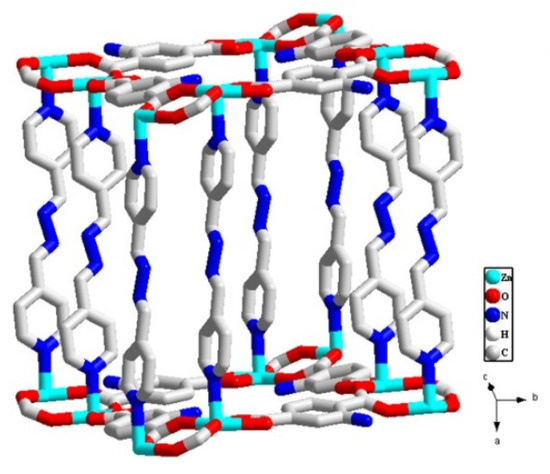
Figure 1.
Structure of the cuboidal block of TMU-17-NH2 showing Zn units linked by eight NH2-BDC and eight 4-bpdb units.
The experimental XRD pattern of the synthesized TMU-17-NH2 was in good agreement with the simulated one, showing the successful preparation of TMU-17-NH2 (Figure 2). The chemical stability of TMU-17-NH2 was examined by suspending samples of the MOF in ethanol, acetonitrile, methanol, tetrahydrofuran, water and dichloromethane. The MOF was found to be soluble in water; however, at the same time, the PXRD (Powder X-ray Diffraction) patterns reveal that TMU-17-NH2 can be resistant to the other solvent’s molecules.
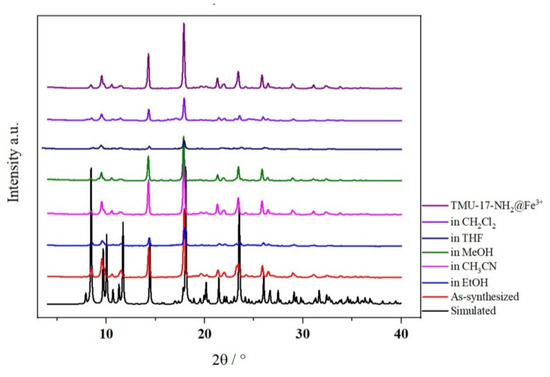
Figure 2.
PXRD of TMU-17-NH2: as-synthesized, simulated; immersed in EtOH, CH3CN, MeOH, THF, CH2Cl2 and TMU-17-NH2@Fe3+.
To examine the potential of TMU-17-NH2 for sensing metal ions, the activated TMU-17-NH2 (1 mg) was immersed in 4 mL DMF solutions containing M(NO3)x (M = Zn2+, Pb2+, Co2+, Cu2+, Cd2+, Al3+, or Fe3+), NaAsO2, Ni(OAc)2 and MnCl2 to form the metal ion-incorporated MOF suspension for luminescence studies. As shown in Figure 3, among the metal ions studied, the quenching effects of Fe3+, Ni2+ and Cu2+ are very pronounced, especially for Fe3+ ions. Moreover, the color changes seen by the naked eye were also recorded (Figure 3, inset).
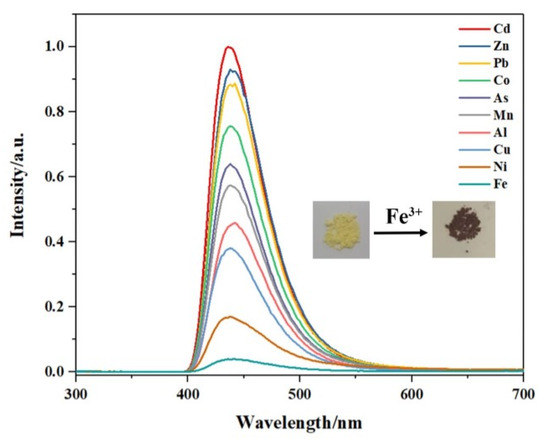
Figure 3.
Emission spectra of TMU-17-NH2 (1 mg) in DMF (4 mL) with various metal ions (250 μM). (Inset: photographs of Fe3+@TMU-17-NH2 sample as solid).
We studied the optical properties of the Mn+@TMU-17-NH2 (M = Fe3+, Ni2+ and Cu2+) when immersing in different concentrations of metal cations (Figure 4). It is obvious that the luminescence intensity at 440 nm is gradually decreased as the concentration of the metal cations increase. The fluorescence quenching follows the Stern–Völmer (SV) equation: I0/I = 1 + KSV[M], where I0 and I correspond to the luminescence intensity for TMU-17-NH2 in absence and presence of metal cations, respectively, [M] is the metal concentration, and KSV is the Stern–Völmer constant. An exceptionally high KSV value of 41,565 M−1 was obtained for Fe3+, while KSV for Ni2+ and Cu2+ were 16,180 and 5766 M−1, respectively. The high sensitivity allows us to easily identify the existence of a small amount of Fe3+ ions. Based on the slope of the calibration curve (K) values and the standard deviations (Sb) from ten repeated fluorescent measurements of blank solutions, the detection limits (3Sb/K) of TMU-17-NH2 towards Fe3+ ion in DMF were calculated to be 0.7 μM (corresponding to 40 ppb).
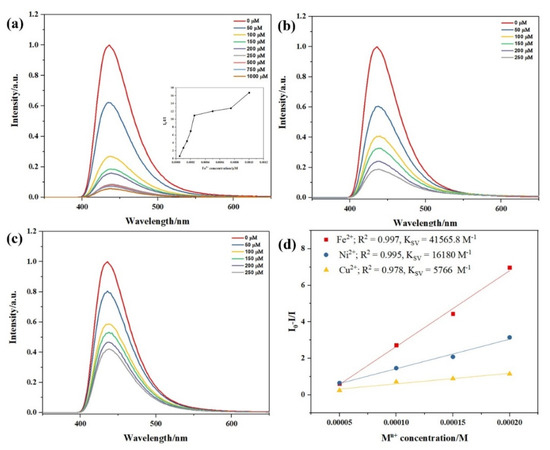
Figure 4.
The luminescence spectra of TMU-17-NH2 with different concentration of (a) Fe3+, (b) Ni2+ and (c) Cu2+ ions. (d) Stern–Völmer (SV) plots of the fluorescence emissions of TMU-17-NH2 quenched by different metal ions in DMF with 270 nm excitation (λem = 436 nm).
It should be pointed out that usually many metal ions coexist in practical biological and environmental systems. Further experiments for the effect of coexisting metal ions on the quenched fluorescence intensity of TMU-17-NH2 using Fe3+ were performed to show the selectivity of TMU-17-NH2 for detecting Fe3+ (Figure 5). It is very encouraging that TMU-17-NH2 shows high anti-interference from other coexisting metal ions.
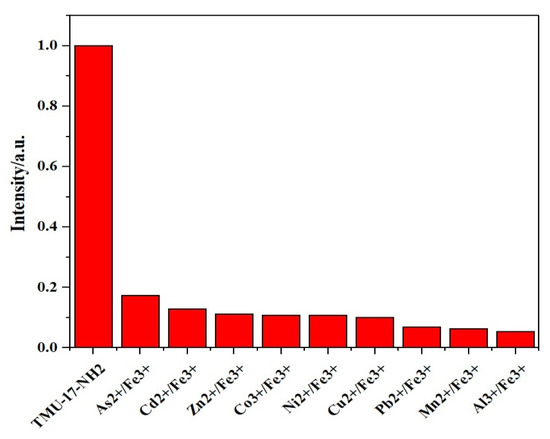
Figure 5.
Comparison of the luminescence intensity of TMU-17-NH2 with 250 μM Fe3+ in DMF in the presence of 250 μM of other metal ions, monitored at 270 nm.
According to the reported literature, porous MOFs with Lewis basic sites, such as pyridyl, amide, and anionic sulfonate sites, can have significant interactions with guest metal ions [10]. We therefore suggest that the quenching might be related to the interaction between the Fe3+ ions and the pendant amine and azine functional groups in TMU-17-NH2. The interaction between the Fe3+ ions and the NH2-BDC ligands minimizes the energy transfer efficiency from NH2-BDC to the Zn2+ ions within TMU-17-NH2, thus decreasing the luminescence intensity.
4. Conclusions
Here, we used an amine-functionalized dicarboxylate ligand as well as a ligand containing a bridging azine group in the middle to functionalize a TMU-17-NH2 luminescent MOF as a stable fluorescent sensor for detecting Fe3+. This luminescent probe shows high selectivity for sensing Fe3+ in DMF solution with excellent sensitivity (Ksv ~ 41,000 M−1) and a detection limit of 0.7 µM. The present results may provide a facile route to design and synthesize functional MOFs with applications in fluorescent sensors.
Acknowledgments
Support of this investigation by Iran University of Science and Technology and Iran′s National Elites Foundation is gratefully acknowledged.
References
- Nelson, P. Important elements. J. Chem. Educ. 1991, 68, 732. [Google Scholar] [CrossRef]
- Hyman, L.M.; Franz, K.J. Probing oxidative stress: Small molecule fluorescent sensors of metal ions, reactive oxygen species, and thiols. Coord. Chem. Rev. 2012, 256, 2333–2356. [Google Scholar] [CrossRef] [PubMed]
- Tanhaei, M.; Mahjoub, A.R.; Safarifard, V. Ultrasonic-assisted synthesis and characterization of nanocomposites from azine-decorated metal-organic framework and graphene oxide layers. Mater. Lett. 2018, 227, 318–321. [Google Scholar] [CrossRef]
- Xiang, Z.; Fang, C.; Leng, S.; Cao, D. An amino group functionalized metal–organic framework as a luminescent probe for highly selective sensing of Fe3+ ions. J. Mater. Chem. A 2014, 2, 7662–7665. [Google Scholar] [CrossRef]
- Zhao, X.-L.; Tian, D.; Gao, Q.; Sun, H.-W.; Xu, J.; Bu, X.-H. A chiral lanthanide metal–organic framework for selective sensing of Fe(iii) ions. Dalton Trans. 2016, 45, 1040–1046. [Google Scholar] [CrossRef] [PubMed]
- Chen, Z.; Sun, Y.; Zhang, L.; Sun, D.; Liu, F.; Meng, Q.; Wang, R.; Sun, D. A tubular europium–organic framework exhibiting selective sensing of Fe3+ and Al3+ over mixed metal ions. Chem. Commun. 2013, 49, 11557–11559. [Google Scholar] [CrossRef] [PubMed]
- Zhou, X.; Li, H.; Xiao, H.; Li, L.; Zhao, Q.; Yang, T.; Zuo, J.; Huang, W. A microporous luminescent europium metal–organic framework for nitro explosive sensing. Dalton Trans. 2013, 42, 5718–5723. [Google Scholar] [CrossRef] [PubMed]
- Dong, X.-Y.; Wang, R.; Wang, J.-Z.; Zang, S.-Q.; Mak, T.C. Highly selective Fe3+ sensing and proton conduction in a water-stable sulfonate–carboxylate Tb–organic-framework. J. Mater. Chem. A 2015, 3, 641–647. [Google Scholar] [CrossRef]
- Safarifard, V.; Beheshti, S.; Morsali, A. An interpenetrating amine-functionalized metal-organic framework as an efficient and reusable catalyst for the selective synthesis of tetrahydro-chromenes. CrystEngComm 2015, 17, 1680–1685. [Google Scholar] [CrossRef]
- Li, J.-R.; Kuppler, R.J.; Zhou, H.-C. Selective gas adsorption and separation in metal–organic frameworks. Chem. Soc. Rev. 2009, 38, 1477–1504. [Google Scholar] [CrossRef] [PubMed]
© 2019 by the authors. Licensee MDPI, Basel, Switzerland. This article is an open access article distributed under the terms and conditions of the Creative Commons Attribution (CC BY) license (http://creativecommons.org/licenses/by/4.0/).